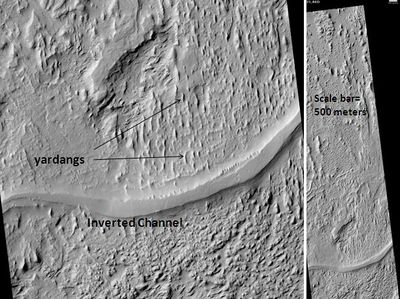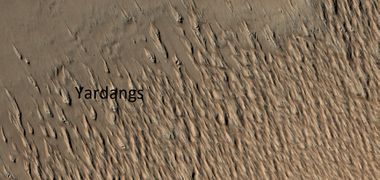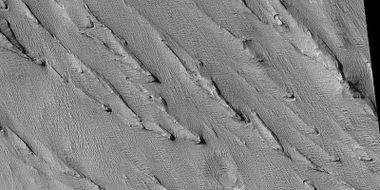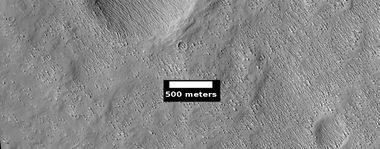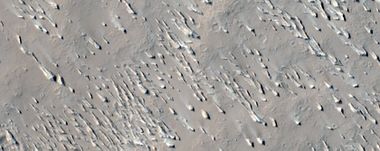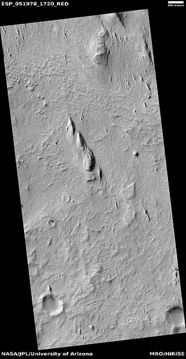Difference between revisions of "Medusae Fossae"
Suitupshowup (talk | contribs) m (→See also) |
Suitupshowup (talk | contribs) m |
||
| (15 intermediate revisions by the same user not shown) | |||
| Line 1: | Line 1: | ||
| − | The | + | The Medusae Fossae Formation is a large geological formation of probable volcanic origin on the planet [[Mars]].<ref> "The Medusa Fossae formation on Mars". European Space Agency. 29 March 2005.</ref> |
| − | + | It is named for the Medusa of Greek mythology. "Fossae" is Latin for "trenches". | |
The formation is a collection of soft, easily eroded deposits that extends off and on for more than 5,000 km along the equator. | The formation is a collection of soft, easily eroded deposits that extends off and on for more than 5,000 km along the equator. | ||
| − | + | Its roughly-shaped regions extend from just south of [[Olympus Mons]] to Apollinaris Patera, with a smaller additional region closer to [[Gale Crater]].<ref>Lujendra Ojha; Kevin Lewis; Suniti Karunatillake; Mariek Schmidt July 20, 2018 The Medusae Fossae Formation as the single largest source of dust on Mars". Nature Communications. ISSN 2041-1723.</ref> | |
| − | + | It has been determined that the Medusae Fossae Formation as the single largest source of dust on Mars.<ref> | |
| + | |url=https://www.nature.com/articles/s41467-018-05291-5/figures/1|journal=Nature Communications|language=en|</ref> | ||
| − | The total area of the Medusae Fossae Formation is equal to 20% the size of the continental United States.<ref name="pmid30030425"> | + | The total area of the Medusae Fossae Formation is equal to 20% the size of the continental United States.<ref name="pmid30030425"> |pmid=30030425 |pmc=6054634 |title=The Medusae Fossae Formation as the single largest source of dust on Mars |journal=Nature Communications |volume=9 |issue=1 |pages=2867 |year=2018 |last1=Ojha |first1=Lujendra |last2=Lewis |first2=Kevin |last3=Karunatillake |first3=Suniti |last4=Schmidt |first4=Mariek |</ref> |
| − | The formation straddles what is called the martian dichotomy|highland - lowland boundary near the Tharsis and | + | The formation straddles what is called the martian dichotomy|highland - lowland boundary near the Tharsis and Elysium volcanic areas, and extends across five quadrangles: [[Amazonis quadrangle|Amazonis]], [[Tharsis quadrangle|Tharsis]], [[Memnonia quadrangle|Memnonia]], [[Elysium quadrangle|Elysium]], and [[Aeolis quadrangle|Aeolis]]. |
== Origin and age == | == Origin and age == | ||
The origin of the formation is unknown, but many theories have been presented over the years. | The origin of the formation is unknown, but many theories have been presented over the years. | ||
| + | In 2020, a group of researchers headed by Peter Mouginis-Mark has hypothesized that the formation could have been formed from pumice rafts from the volcano [[Olympus Mons]].<ref>Scientists Float a New Theory on the Medusae Fossae Formation". Eos. 19 May 2020.</ref> In 2012, a group headed by Laura Kerber hypothesized that it could have been formed from ash from the volcanoes Apollinaris Mons, Arsia Mons, and possibly Pavonis Mons.<ref>{{cite journal |doi=10.1016/j.icarus.2012.03.016 |title=The dispersal of pyroclasts from ancient explosive volcanoes on Mars: Implications for the friable layered deposits |journal=Icarus |volume=219 |issue=1 |pages=358–381 |year=2012 |last1=Kerber |first1=Laura |last2=Head |first2=James W. |last3=Madeleine |first3=Jean-Baptiste |last4=Forget |first4=François |last5=Wilson |first5=Lionel | }}</ref> | ||
| − | + | Its density and high content of sulfur and chlorine, suggests an explosive volcanic origin. It may have been deposited in periodic eruptions over an interval of 500 million years.<ref name="Ojha2018a">{{cite journal |doi=10.1029/2018JE005565 |title=The Density of the Medusae Fossae Formation: Implications for its Composition, Origin, and Importance in Martian History |journal=Journal of Geophysical Research: Planets |volume=123 |issue=6 |pages=1368–1379 |year=2018 |last1=Ojha |first1=Lujendra |last2=Lewis |first2=Kevin |</ref> | |
| + | The surface of the formation has been eroded by the wind into a series of linear ridges called yardangs. The wind shapes things by bouncing sand particles.<ref>Bridges, Nathan T.; Muhs, Daniel R. (2012). "Duststones on Mars: Source, Transport, Deposition, and Erosion". Sedimentary Geology of Mars. pp. 169–182. doi:10.2110/pec.12.102.0169. ISBN 978-1-56576-312-8.</ref> Layers are seen in parts of the formation. <ref> |title=Sedimentary Geology of Mars |pages=169–182 |year=2012 |last1=Bridges |first1=Nathan T. |last2=Muhs |first2=Daniel R. |isbn=978-1-56576-312-8 }}</ref> These ridges generally point in direction of the prevailing winds that carved them, and demonstrate the erosive power of Martian winds. The easily eroded nature of the Medusae Fossae Formation suggests that it is composed of weakly cemented particles, and was most likely formed by the deposition of wind-blown dust or volcanic ash. Layers are seen in parts of the formation. | ||
| + | Yardangs are common on Mars.<ref>Grotzinger, J. and R. Milliken (eds.) 2012. Sedimentary Geology of Mars. SEPM</ref> They are generally visible as a series of parallel linear ridges. Their parallel nature is thought to be caused by the direction of the prevailing wind.<ref>name="hiroc.lpl.arizona.edu"</ref> | ||
| − | + | [[Image:Aeolis Mensae Yardangs.JPG|left|thumb|400px|Aeolis Mensae Yardangs, as seen by HiRISE. Scale bar is 500 meters long. An inverted stream channel is also visible]] | |
| + | <gallery class="center" widths="380px" heights="360px"> | ||
| + | File:Medusae map.jpg|Map of location of Medusae Fossae Formation | ||
| − | |||
| − | + | </gallery> | |
| − | |||
| − | + | <gallery class="center" widths="380px" heights="360px"> | |
| − | + | File:61167 1735yardangs3.jpg|Yardangs | |
| − | + | File:35558 1830yardangs.jpg|Yardangs in Amazonis quadrangle | |
| + | File:ESP 045831 1750yardangswide.jpg|Wide view of yardangs in Amazonis quadrangle | ||
| + | File:ESP 045831 1750yardangscolor.jpg|Close, color view of yardangs in Amazonis quadrangle | ||
| + | Images from spacecraft show that they have different degrees of hardness probably because of significant variations in the physical properties, composition, particle size, and/or cementation. Very few impact craters are visible throughout the area so the surface is relatively young.<ref>{{cite web | url=http://themis.asu.edu/zoom-20020416a | title=Medusae Fossae Formation | Mars Odyssey Mission THEMIS }}</ref> | ||
| − | |||
| − | |||
Image:Apollinarisandmedusae.JPG|Medusae Fossae Formation southeast of Apollinaris Patera | Image:Apollinarisandmedusae.JPG|Medusae Fossae Formation southeast of Apollinaris Patera | ||
File: ESP 051978 1720yardangslayers.jpg|Small yardangs | File: ESP 051978 1720yardangslayers.jpg|Small yardangs | ||
| − | |||
</gallery> | </gallery> | ||
| − | |||
| − | |||
| − | |||
==See also== | ==See also== | ||
| Line 59: | Line 60: | ||
* [https://www.youtube.com/watch?v=_sUUKcZaTgA Martian Ice - Jim Secosky - 16th Annual International Mars Society Convention] | * [https://www.youtube.com/watch?v=_sUUKcZaTgA Martian Ice - Jim Secosky - 16th Annual International Mars Society Convention] | ||
| − | * | + | * |
| − | |||
| − | |||
| − | |||
| − | |||
| − | |||
==References== | ==References== | ||
{{reflist|colwidth=30em}} | {{reflist|colwidth=30em}} | ||
Latest revision as of 07:29, 8 January 2024
The Medusae Fossae Formation is a large geological formation of probable volcanic origin on the planet Mars.[1]
It is named for the Medusa of Greek mythology. "Fossae" is Latin for "trenches". The formation is a collection of soft, easily eroded deposits that extends off and on for more than 5,000 km along the equator.
Its roughly-shaped regions extend from just south of Olympus Mons to Apollinaris Patera, with a smaller additional region closer to Gale Crater.[2]
It has been determined that the Medusae Fossae Formation as the single largest source of dust on Mars.[3]
The total area of the Medusae Fossae Formation is equal to 20% the size of the continental United States.[4]
The formation straddles what is called the martian dichotomy|highland - lowland boundary near the Tharsis and Elysium volcanic areas, and extends across five quadrangles: Amazonis, Tharsis, Memnonia, Elysium, and Aeolis.
Origin and age
The origin of the formation is unknown, but many theories have been presented over the years.
In 2020, a group of researchers headed by Peter Mouginis-Mark has hypothesized that the formation could have been formed from pumice rafts from the volcano Olympus Mons.[5] In 2012, a group headed by Laura Kerber hypothesized that it could have been formed from ash from the volcanoes Apollinaris Mons, Arsia Mons, and possibly Pavonis Mons.[6]
Its density and high content of sulfur and chlorine, suggests an explosive volcanic origin. It may have been deposited in periodic eruptions over an interval of 500 million years.[7]
The surface of the formation has been eroded by the wind into a series of linear ridges called yardangs. The wind shapes things by bouncing sand particles.[8] Layers are seen in parts of the formation. [9] These ridges generally point in direction of the prevailing winds that carved them, and demonstrate the erosive power of Martian winds. The easily eroded nature of the Medusae Fossae Formation suggests that it is composed of weakly cemented particles, and was most likely formed by the deposition of wind-blown dust or volcanic ash. Layers are seen in parts of the formation.
Yardangs are common on Mars.[10] They are generally visible as a series of parallel linear ridges. Their parallel nature is thought to be caused by the direction of the prevailing wind.[11]
See also
- Geography of Mars
- High Resolution Imaging Science Experiment (HiRISE)
- HiWish program
- Layers on Mars
- Mars Global Surveyor
External links
References
- ↑ "The Medusa Fossae formation on Mars". European Space Agency. 29 March 2005.
- ↑ Lujendra Ojha; Kevin Lewis; Suniti Karunatillake; Mariek Schmidt July 20, 2018 The Medusae Fossae Formation as the single largest source of dust on Mars". Nature Communications. ISSN 2041-1723.
- ↑ |url=https://www.nature.com/articles/s41467-018-05291-5/figures/1%7Cjournal=Nature Communications|language=en|
- ↑ |pmid=30030425 |pmc=6054634 |title=The Medusae Fossae Formation as the single largest source of dust on Mars |journal=Nature Communications |volume=9 |issue=1 |pages=2867 |year=2018 |last1=Ojha |first1=Lujendra |last2=Lewis |first2=Kevin |last3=Karunatillake |first3=Suniti |last4=Schmidt |first4=Mariek |
- ↑ Scientists Float a New Theory on the Medusae Fossae Formation". Eos. 19 May 2020.
- ↑ "The dispersal of pyroclasts from ancient explosive volcanoes on Mars: Implications for the friable layered deposits" (2012). Icarus 219 (1): 358–381. doi:.
- ↑ "Sedimentary Geology of Mars" (2012). Journal of Geophysical Research: Planets 123 (6): 169–182. doi:.
- ↑ Grotzinger, J. and R. Milliken (eds.) 2012. Sedimentary Geology of Mars. SEPM
- ↑ name="hiroc.lpl.arizona.edu"
